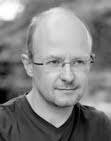Another lesson, from K.V.
Another lesson, this time from South African composer Kevin Volans:
Show your wound but allow yourself to be healed. Feldman made it clear that what mattered was NOT A METHOD OF COMPOSITION, BUT AN ATTITUDE TOWARDS MUSIC. I understand this as involving a feeling (love) for material ("know thy instrument"), an awareness that everything depends on the context (no universal rules for all situations), and a sensitivity to image. If there are to be no fixed laws of composition, no formal concepts, then musical discussion (even of technique) needs be via imagery - metaphor. There is a popular song of the thirties called Dancing in the Dark. It struck me that this gives a neat description of what I regard as an ideal approach to composition. It's very specific. If you dance in the dark, you know exactly WHAT you are doing. WHERE you are and where you are going is less clear. Obviously, some skill is required (in the thirties one danced with a partner and hopefully there were other dancers on the floor). There is a difference between dancing in the dark and stumbling in the dark. WHY you are dancing is an existential question. I can't think of any good justification for it - one dances for the joy of it and for establishing a relationship with an unseen partner. Only when you make a mistake or when someone turns on the lights does it become a social question. Turning on the lights makes what you are doing public. It also makes you aware of what others are doing. Obviously this has its value, but it carries with it the temptation to compete with others from the point of view of style, at the expense of sensation. You no longer do something for how it feels, but for how it looks. The struggle to grasp the reality of what you are doing in the dark is easily deflected into competitive display in the bright light of the marketplace.
Show your wound but allow yourself to be healed. Feldman made it clear that what mattered was NOT A METHOD OF COMPOSITION, BUT AN ATTITUDE TOWARDS MUSIC. I understand this as involving a feeling (love) for material ("know thy instrument"), an awareness that everything depends on the context (no universal rules for all situations), and a sensitivity to image. If there are to be no fixed laws of composition, no formal concepts, then musical discussion (even of technique) needs be via imagery - metaphor. There is a popular song of the thirties called Dancing in the Dark. It struck me that this gives a neat description of what I regard as an ideal approach to composition. It's very specific. If you dance in the dark, you know exactly WHAT you are doing. WHERE you are and where you are going is less clear. Obviously, some skill is required (in the thirties one danced with a partner and hopefully there were other dancers on the floor). There is a difference between dancing in the dark and stumbling in the dark. WHY you are dancing is an existential question. I can't think of any good justification for it - one dances for the joy of it and for establishing a relationship with an unseen partner. Only when you make a mistake or when someone turns on the lights does it become a social question. Turning on the lights makes what you are doing public. It also makes you aware of what others are doing. Obviously this has its value, but it carries with it the temptation to compete with others from the point of view of style, at the expense of sensation. You no longer do something for how it feels, but for how it looks. The struggle to grasp the reality of what you are doing in the dark is easily deflected into competitive display in the bright light of the marketplace.


0 Comments:
Post a Comment
<< Home